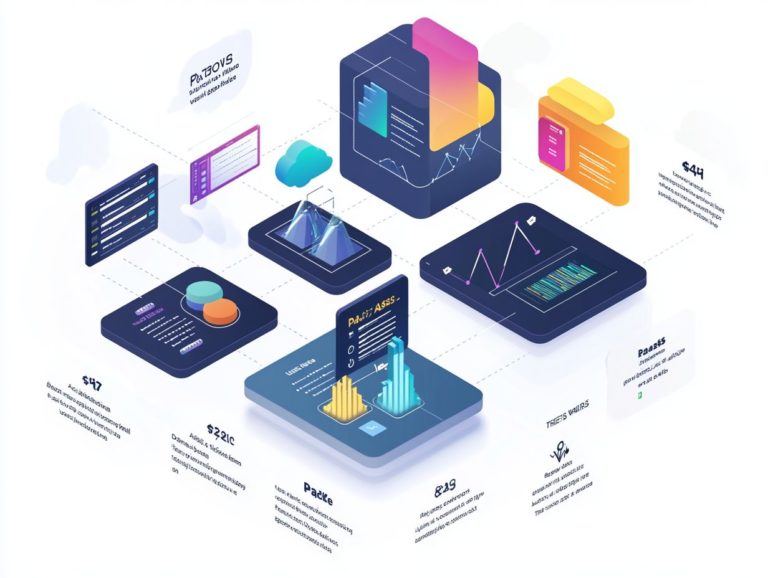PaaS and Customer Experience: Enhancing Services
In today’s fast-paced digital landscape, you re likely on the lookout for innovative solutions that can streamline operations and elevate customer experiences.
Platform as a Service (PaaS) has emerged as a powerful ally. It provides a flexible environment for you and your developers to build, deploy, and manage applications with impressive efficiency.
This article delves into the core definitions and features of PaaS. We will highlight its benefits for your business and its significant impact on customer service.
You will also discover how to choose the right PaaS provider and ensure successful implementation, backed by real-life case studies.
Discover how PaaS can transform your organization today!
Contents
- Key Takeaways:
- Understanding PaaS (Platform as a Service)
- Benefits of PaaS for Businesses
- Impact of PaaS on Customer Experience
- Choosing the Right PaaS Provider
- Implementing PaaS in Your Business
- Case Studies of Successful PaaS Implementation
- Frequently Asked Questions
- What is PaaS and How Does It Enhance Customer Experience?
- How Does PaaS Benefit Businesses in Terms of Customer Experience?
- Can PaaS Be Customized to Fit the Unique Needs of a Business?
- What Are Some Examples of PaaS Solutions That Can Enhance Customer Experience?
- Is PaaS Suitable for Businesses of All Sizes?
- How Can PaaS Help Businesses Stay Competitive in Today’s Market?
Key Takeaways:

- PaaS streamlines processes and improves efficiency, helping businesses meet customer needs.
- Choosing the right PaaS provider is crucial; focus on security and scalability.
- Successful integration of PaaS enhances services and improves overall customer experience.
Understanding PaaS (Platform as a Service)
Understanding PaaS (Platform as a Service) is essential in today s fast-paced technological landscape. You re constantly seeking efficiency and agility for your business.
PaaS provides a cloud computing solution. You can create, deploy, and manage applications without worrying about infrastructure.
PaaS integrates development tools and scalable resources. This allows you to focus on innovation while cutting costs.
As Software-as-a-Service (SaaS) and Infrastructure-as-a-Service (IaaS) are gaining momentum, PaaS is now a crucial component of your digital transformation.
Definition and Key Features
The essence of Platform-as-a-Service (PaaS) lies in its ability to offer a cloud computing environment. It simplifies your application development and deployment process.
This innovative solution not only streamlines your development efforts. It also provides a low-code environment, allowing you to create applications with minimal hand-coding.
PaaS platforms equip you with intuitive interfaces and robust development tools. These features foster collaboration and agile practices.
Together, these elements elevate customer value by reducing your time-to-market and operational costs. They ensure efficient resource management and flexible software licensing options.
In a PaaS environment, your organization can focus on innovation, free from the burdens of managing underlying infrastructure.
Benefits of PaaS for Businesses
The advantages of PaaS for businesses are abundant. It enables you to enhance customer value while optimizing operational costs.
By embracing a subscription model, you can streamline your development processes. This allows for a quicker time-to-market for your business applications all without the complexities of managing hardware or software infrastructure.
This flexibility enables you to adapt seamlessly to changing market conditions. It fosters innovation and maximizes profit through agile methodologies.
Streamlining Processes and Improving Efficiency
PaaS significantly streamlines your processes and enhances efficiency across various business applications. It allows you to concentrate on your core competencies rather than getting bogged down in IT management.
This platform-as-a-service model automates routine tasks like software updates and system monitoring. It dramatically reduces the need for extensive maintenance support.
As a result, you can allocate your resources more effectively, leading to minimized operational costs and improved productivity.
With powerful development tools that facilitate rapid application development, PaaS not only speeds up delivery times but also elevates customer satisfaction. Ultimately, you can leverage these capabilities to create innovative solutions while fostering a responsive environment that quickly adapts to market demands.
Impact of PaaS on Customer Experience

The impact of PaaS on your customer experience is transformative. Understanding the importance of user experience in PaaS allows you to harness smart products and product customization to meet evolving customer needs.
PaaS enables the swift deployment of applications that enhance user engagement and satisfaction. This allows you to extract valuable customer insights through robust analytics tools.
This approach nurtures loyalty and opens the door to innovative solutions tailored to individual preferences, driving your business toward success.
Enhancing Services and Meeting Customer Needs
PaaS elevates your services. It effectively meets customer needs through the integration of applications and real-time data analytics.
This technology helps you quickly adapt to changing customer needs, ensuring that your service contracts are not merely fulfilled but consistently exceeded.
By leveraging advanced business intelligence tools, you can analyze performance metrics. This analysis directly informs your customer-centric strategies.
With PaaS, you gain the agility to pivot quickly. You can deliver personalized experiences and tailored solutions that truly resonate with your audience.
This flexibility cultivates stronger relationships with customers, driving greater loyalty and satisfaction.
Choosing the Right PaaS Provider
Selecting the ideal PaaS provider is a pivotal decision for organizations aiming to harness the power of cloud technology for application development.
You need to consider factors such as service reliability, scalability, and how well the provider aligns with current market dynamics. These considerations help you find the best fit for your business.
Assessing crucial features like maintenance support, billing models, and pricing strategies significantly impacts overall success and the sustainability of your cloud initiatives.
Factors to Consider and Key Features to Look For
When evaluating PaaS options, prioritize key features: scalability, security, and exemplary customer support from the cloud service provider.
Carefully examine service-level agreements (SLAs). This ensures the provider is dedicated to maintaining high levels of availability and responsiveness.
Customization options are equally important. They directly influence how well the platform can be tailored to meet your specific business needs.
Understanding the provider’s approach to implementing upgrades and enhancements provides valuable insights into long-term performance improvement.
Together, these factors significantly contribute to lowering operational costs while maximizing efficiency and customer insights. This ensures you have a robust and future-proof infrastructure.
Implementing PaaS in Your Business
Implementing PaaS can revolutionize your development process! However, it demands meticulous planning and execution to facilitate a seamless transition.
Embracing best practices for integration is essential. Align your development tools with your current business applications and ensure your team is well-trained in the new environment.
By taking these steps, you can unlock the full potential of PaaS, paving the way for enhanced efficiency and innovation throughout your operations.
Best Practices and Tips for Successful Integration

Best practices for seamlessly integrating PaaS into your business encompass meticulous planning, ongoing monitoring, and an emphasis on enhancing user experience.
To truly harness the potential of this powerful platform, embrace an approach grounded in iterative testing and regular feedback loops. These strategies facilitate adjustments based on genuine user needs.
By utilizing cost-effective development tools, you can streamline your operations. This effectively reduces costs while boosting productivity.
As your team continuously refines solutions informed by user input, they will align their offerings more closely with client expectations. This creates a culture of innovation and responsiveness that fuels long-term success!
Case Studies of Successful PaaS Implementation
Case studies showcasing successful Platform as a Service (PaaS) implementation reveal the transformative power of cloud technology across diverse industries, shown by major corporations like Xerox, Philips, and Rolls-Royce.
These industry leaders have skillfully harnessed PaaS to refine their development processes. Embracing PaaS has helped them cut operational costs. It also improved their scalability and responsiveness to changing market demands.
Real-Life Examples and Results
Real-life examples of PaaS implementations showcase impressive results. They illustrate how you can enhance profit maximization and elevate customer engagement through strategic cloud adoption.
For instance, a recent case study of a prominent retail company achieved a remarkable 30% reduction in operational costs by migrating key services to a PaaS environment. This transition streamlined their processes and led to an impressive 25% boost in customer satisfaction scores, thanks to faster service delivery and enriched user experiences.
Organizations like yours that leverage advanced analytics tools integrated within PaaS have reported a staggering 40% increase in market expansion efforts. By effectively harnessing data insights, they tailored their products and services to meet diverse customer needs.
These tangible benefits clearly highlight the transformative impact of cloud platforms on modern business strategies.
Frequently Asked Questions
What is PaaS and How Does It Enhance Customer Experience?
PaaS stands for Platform as a Service. It is a cloud computing model that provides a platform for users to develop, run, and manage applications without the complexity of building and maintaining the underlying infrastructure. PaaS enhances customer experience by enabling businesses to quickly deploy customer-focused applications and services, improving efficiency and responsiveness.
How Does PaaS Benefit Businesses in Terms of Customer Experience?

PaaS offers a variety of benefits for businesses looking to enhance their customer experience. It can improve agility and speed to market, reduce costs, and increase scalability and flexibility. With the role of PaaS in innovation, businesses can access advanced tools to develop and deploy innovative applications that enhance overall customer experience.
Can PaaS Be Customized to Fit the Unique Needs of a Business?
Yes, PaaS can be customized to fit the specific needs and requirements of a business. PaaS providers offer a range of tools and services tailored to industry-specific goals. This allows businesses to create a unique and personalized experience for their customers.
What Are Some Examples of PaaS Solutions That Can Enhance Customer Experience?
Various PaaS solutions in e-commerce enhance customer experience. Examples include customer relationship management (CRM) platforms, chatbot and virtual assistant platforms, and web and mobile application development platforms. These solutions help businesses improve communication, streamline processes, and provide a seamless and personalized experience for customers.
Is PaaS Suitable for Businesses of All Sizes?
Yes, PaaS can benefit businesses of all sizes. It offers an affordable and scalable solution for small and medium-sized businesses while providing advanced tools for larger enterprises. Whether just starting or already well-established, PaaS can enhance customer experience and drive growth.
How Can PaaS Help Businesses Stay Competitive in Today’s Market?
PaaS empowers your business to seize a competitive edge quickly. It enables businesses to adapt to market changes and customer demands. With PaaS, companies can easily develop and deploy new applications to meet evolving needs, keeping them ahead of their competition. PaaS also offers continuous updates, ensuring businesses always use the latest technologies to enhance their customer experience.
In conclusion, adopting PaaS can significantly transform your business strategies and customer interactions. Are you ready to explore how PaaS can elevate your customer relationships?






